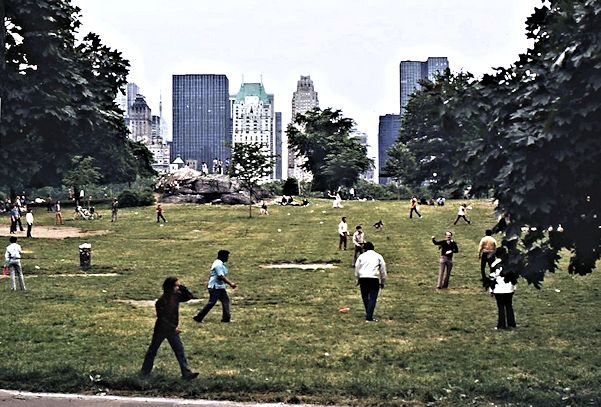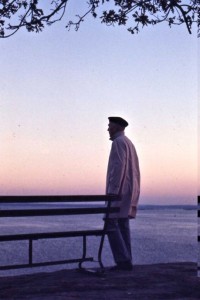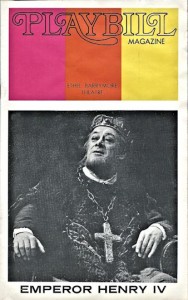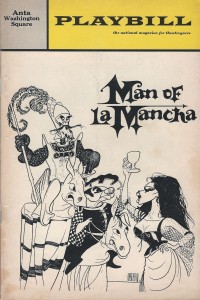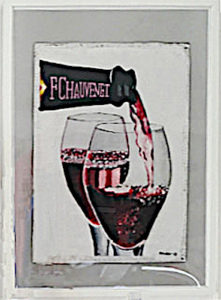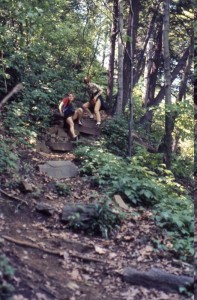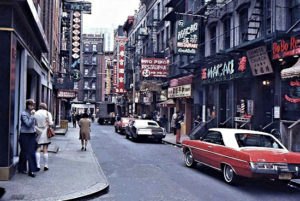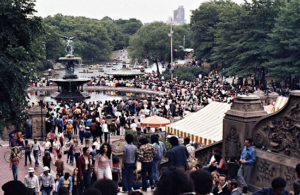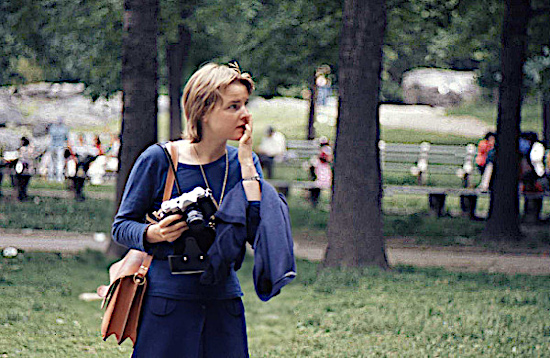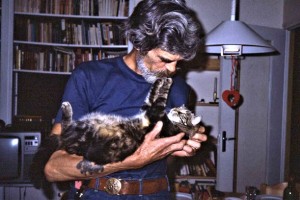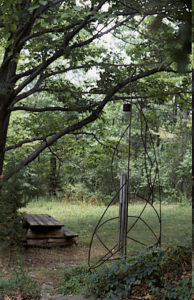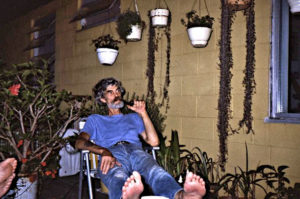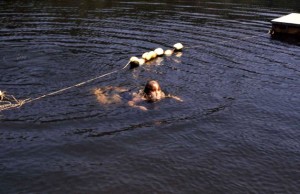One of the most fun events during the year John and I lived together in New Rochelle was when we had dinner at the Asti Restaurant in Greenwich Village on East 12th Street. The food was delicious, but there was a lot more to Asti. The entire staff sings, the waiters, the bartender, the coat check girl, and even the chef. All of a sudden the lights go down and in from the kitchen comes a long line of monks dressed in hooded black robes, carrying candles and doing an amazingly good performance of the Miserere and Anvil Chorus from Verdi’s “Il Trovatore”‘. For the Anvil Chorus the bartender bangs on the bottles to mimic the effect of the beating of the anvils. The staff are all of them excellent singers, many of them professionals. Headed by the chef they wind their way in a long parade through the restaurant singing the chorus in a smashing performance and ending up back in the kitchen regions. The Miserere, which comes after the Anvil Chorus, later on in the opera, is a trio for soprano, tenor and chorus. Both solo singers were excellent, and the chorus is dark and ominous, as it should be. This was definitely a very special treat. An absolutely unforgettable and hilariously funny event.1 Sadly this wonderful show ended in 1999, and it’s now nothing but a wonderful memory. We went back to Asti a bit later on to see the show once again, this time with John’s parents, Margaret and Bert, who were visiting us in the fall of 1972, and they loved it too.
During that visit there was an incident that almost turned out bad. We had gone to the City to see the musical “Beatrice and Benedict”, the plot being based on Shakespeare’s “Much Ado About Nothing”. As we made our way up the stairs to get to our seats, there was a sudden backup, and we had no idea what it was all about. It turned out that some people were hired to search all bags and purses and of course it slowed down our progress. We still had no idea what it was about. We finally got to our seats and then a whisper started going around “The President is here tonight.” That was Nixon. John said “Jesus, not him.” and his mother, Margaret, got furious and said “If you say something like that one more time, I’m leaving.” Well, we didn’t quite know how she would leave and get back to New Rochelle, but John was quiet from then on. Just before the show started, the entire audience stood up and sang “The star-spangled banner”. Except John and me. There was, surprisingly enough, no comment about this from Margaret.
Before the show, as we were walking around the city a bit, we stopped for a milkshake in a milk-bar. I asked the waitress, who happened to be black what flavors they had. She said “Just one, honey – you and me.” That was exactly what I wanted so all was fine. I told her that Black and white had always been my favorite. I think she smiled.
_______________
But enough chatting about opera and the most fabulous ballet I have ever seen. There was more theater and also musicals. We saw Pirandello’s “Emperor Henry IV”‘ with Rex Harrison — no less — directed by Clifford Williams in the spring of 1973. It was a British production that came to New York City that spring. We saw it at the Ethel Barrymore Theatre on Broadway. It was of course an event seeing Rex Harrison alive on stage, even though he did seem a bit old. He was actually over 60 when he played this part, but his stage presence and his voice were magnificent, as always. I can not help but think of Professor Higgins in “My Fair Lady” though, when I hear Rex Harrison’s voice, but this role was indeed different.
In April ’73 we saw at the “Circle in the Square” the outstanding Irish actress Siobhan McKenna in a one-woman show with the title “Here Are Ladies”, which was originally the title of a poem by the Irish writer and poet James Stephens. She performed excerpts by various Irish authors, Sean O’Casey, James Stephens, “Saint Joan” by George Bernhard Shaw, W.B Yeats, J.M Synge and “Happy Days” — “Oh les beaux jours” – by Samuel Becket. It was all magnificent theater, and she got thunderous applause. John and I were to see “Oh les beaux jours’”, this wonderful pla,y at the Théâtre du Rond-Point in Paris in 1981 with Madeleine Renaud, another amazing performance.
The second act was all by James Joyce, two excerpts from Finnegan’s Wake, the marvelous “Anna Livia Plurabelle” and the “Lullaby”. The show ended with Molly’s soliloquy at the very end of Ulysses – Yes. unforgettable. The very essence of sensuality. Molly says Yes to love – here reminiscing about former lovers, especially one in Gibraltar.
The final words of Molly’s reverie, and the very last words of the book, are:
“I was a Flower of the mountain yes when I put the rose in my hair like the Andalusian girls used or shall I wear a red yes and how he kissed me under the Moorish Wall and I thought well as well him as another and then I asked him with my eyes to ask again yes and then he asked me would I yes to say yes my mountain flower and first I put my arms around him yes and drew him down to me so he could feel my breasts all perfume yes and his heart was going like mad and yes I said yes I will Yes.”
It’s an absolutely glorious ending, but like the silly woman that I am, when I read the book’s final chapter, I felt sorry for Leopold. He had been wandering all over Dublin on that day, on June 16, and he was treated condescendingly in several instances, sometimes because he is Jewish. He adored his sensuous wife who was regularly having affairs with other men. It is heartbreaking, if you see it from that angle. But I get deeply moved every time I hear Molly’s soliloquy, read it or even think of it. It shakes you up. It gets inside you.
A funny thing was the big question about the musical “Man of La Mancha”, inspired by Cervantes’ “Don Quixote”. When exactly we saw it was first a complete mystery for us. Why did my program say 1967 since we saw it together? Well, we didn’t. The program I have gave us some detective work, since John and I were both sure we had seen it together. However, I must have seen it with Allyn in 1967 at the “ANTA Washington Square Theatre” in Greenwich Village, and John saw it a year later at the Martin Beck Theatre on Broadway, obviously long before we knew each other. That was the year before he moved to Paris in the fall of 1969, after two years at Brookhaven National Laboratory on Long Island.
At the time I had not read Don Quixote and I would most certainly have remembered it much better if I had. I loved Cervantes’ novel when I finally read it quite a few years ago. And that’s when it became clear to me that Sancho Panza is the real hero of the book, the one who again and again gets his master, the mad knight, out of real trouble whenever he has one of his whimsical ideas of saving damsels in distress, or some equally silly thing.
Richard Kiley won a Tony Award for his performance as Don Quixote in the original production, After 2,329 performances of the original version, the musical was repeatedly revived, the last time in 2002. It was made into a movie with Peter O’Toole as Don Quixote, with a professional singer doing the sound track.
__________________
In the middle of the spring term we had a visit from a friend and former colleague of John’s from Collège de France. Jacques, whom I also knew somewhat. He was traveling around the United States, seeing friends here and there and then in the end, while he attended the APS — American Physical Society — meeting in the city, spending quite a few days with us. We of course showed him around the City in a very thorough way and he greatly appreciated John’s guiding. John is indeed an excellent guide, which I am not.
One evening we were having dinner at home with Mélisande purring somewhere close by, when Jacques suddenly said. “Hey, John, what would you say about coming back to Paris to become a computing engineer in the Computing Center for Physics research that I will be directing starting this fall?” It was the beginning of the CCPN (Centre de Calcul de Physique Nucléaire,) in the CNRS 2 John’s reply was “When do we pack?” Jacques, in the way of all too many French men, had only been addressing John, (even though I clearly remember him having admired my brand new diamond ring, so he knew perfectly well that John wasn’t going to move back to Paris alone.) but John replied for both of us.
John’s reply was to become a never-ending family joke, even though it was said very much in earnest. Jacques, who became a dear friend with his entire family, was about to change our lives. John was to become one of the two engineers at the very beginning of the Centre de Calcul — and the only one with a Ph.D –, Jacques’s nephew, Daniel, being the other one. The Center grew very fast. When the CCPN and we moved to Lyon, because of supposedly-political decentralization, the speed of growth of the computing center increased enormously and today there are so many engineers that, even before John’s generation started their retirements, I didn’t know half of them. A new wing has been added to the original building, which already seemed fairly big.
The Centre de Calcut is located on the campus of some of Lyon university buildings and some “grandes écoles”. The three Lyon universities are spread all over the Lyon area, north and east from the original buildings on the Rhône, where ‘my’ university was – the place where I felt happy in this city that never really welcomed me. My various classes at l’Université Lyon III in linguistics, for le professeur Haudry and several other professors were the place where I felt welcome and belonging. But more about that in another chapter. First there was Paris, where I was very lucky and got many lasting friends.
__________________
Then there was the momentous visit of my dear niece Kajsa. After some health problems of hers it was decided that she should take a year off and so, one day in May she came to stay with us in New Rochelle and stayed for maybe a month or so.
One Sunday evening after we had been out sailing all day, we were invited to Girv’s place with Kajsa, together with actors, a gorgeous woman violinist called Olivia, who Girv was visibly enamored with. There was a photographer who was trying to put the make on Kajsa, a couple of musicians and more of the bohemian kind of people.
On entering the living room, Girv introduced me as his friend Siv, short for syvilis, and everybody thought that was hilarious, except maybe me.
Kajsa had been lying flat on her stomach in the bow of Kijé all day, and she looked fresh and rested. Poor me, I had been at the tiller with sunglasses on and my face was little by little turning into the looks of a boiled lobster, except for the white circles around my eyes. I never use powder so there was nothing I could do about my red face except feel uncomfortable and extremely unattractive, while my niece and the other beautiful young women were sitting around on the floor looking smart and attractive.
We became in a way Kajsa’s vice parents, and she came with me to school every day and got to know and become friends with my dear student Nora and her friend Rita who didn’t take French. I remember that in art class, Nora’s art class certainly, Kajsa sculpted a very nice little thing, besides doing the fine acrylic painting that is reproduced here. I know she still has it. So Kajsa who is now a French and English teacher like me, got to see the enormous difference between a Swedish Gymnasium and a U.S high school.
We went sailing more times in my little Rhodes 19. I loved my boat and I loved sailing. I think Kajsa enjoyed it too, even though John did not.
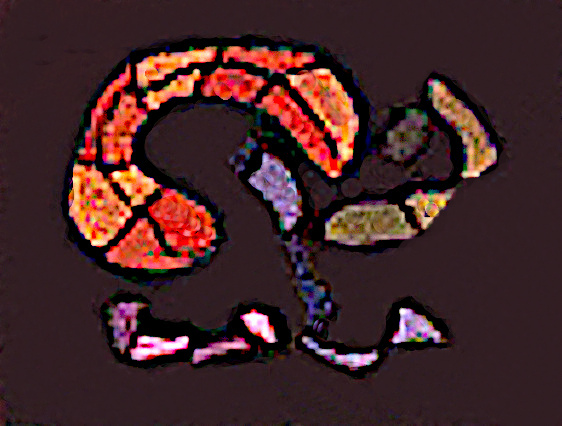
Painting by niece Kajsa when she was 14-15 years old On my wall in 1971 on rue Jean de Beauvais, 5ème. Water color.
One Sunday we went hiking in the rocky park called the Palisades on the west shore of the Hudson River.
We crossed George Washington Bridge from northern Manhattan and we got to this wonderful hiking area on the edge of New Jersey and so very close to New York City.
John and I had made this hike once before. The path climbs and descends and climbs again. My sister Gun told me years later that Kajsa had said about us “Oh wow, what stamina they had!”
During the month or so that Kajsa was staying with us, we of course visited New York City several times, walking around downtown Greenwich Village on one occasion, eating sauerkraut and hotdogs from a stand in the street downtown, as I remember.
Sauerkraut is an originally German invention that we don’t have in Sweden, so that too was exotic. I think that was the day we also walked around in Chinatown.
One Sunday we walked around Lincoln Center, obviously a must to see for Kajsa. From there we went on to Central Park. We went into the park from the west side and we walked up towards the center and the Bethesda Fountain, where there was the usual Sunday enormous crowd of people. It is amazing to think that when you have arrived at this high-point gathering place you are only halfway to the northern end, the Harlem end, of the park.
And of course we saw some great shows. Above all Alvin Ailey Dance Theater at the “New York City Center” on 55th Street, which we saw with niece Kajsa. The star was extraordinary Judith Jamison, who later took over the management of the entire dance theater. They were all black dancers – and that was dancing!
In an intermission, Dick Gregory, the already well established black comedian, writer and anti-war fighter, came out from behind the curtains and appealed to the audience to contribute to the Alvin Ailey dance theater. Cups went up and down the rows in multiple places of the theater, and I don’t doubt that they collected a sizeable amount of money for their cause, which was most likely connected to the Vietnam war. It could well have been war veterans, for instance, who generally suffer so much after a war and who are not often heard.
We also saw a very funny show, black too, “Don’t Bother Me, I Can’t Cope” at the Edison Theatre on Broadway. I just remember that we laughed a lot and that Kajsa never seems to have forgotten the title. For years afterwards, she kept saying “Don’t bother me, I can’t cope”, with a chuckle, if someone got in her way when she was busy doing something.
And that was not all. Also with Kajsa, we saw Ibsen’s play “Ghosts” at the downtown “Roundabout Theatre”. The most striking part of this dynamic performance was the set-up of the area where the play was acted out. There was no stage as such and you felt that you were in the play. There was a circular area for the actors, and we, the audience, were sitting all around it. The name of the theater was well chosen. An actor might walk right by you on his way off the “stage”, and there was no border between actors and audience. “Ghosts” is a morbid play about a dysfunctional marriage and the sins of the father that come back to haunt the son. Oswald has inherited syphilis from his father, Captain Alving. It was an excellent performance, and it is clearly a play that appeals to U.S. theater directors, since it has been revived and lauded several times after the production we saw.
My fellow countrymen, or in the case of Ibsen, next-door countryman, certainly enjoy writing morbid plays about family disasters, such as Ibsen’s “The Wild Duck” and Strindberg’s “The Father”, both plays written in the 1880s. I think it is safe to say that no play can be darker than “‘The Wild Duck’”, which ends with the daughter, Hedvig, committing suicide because she believes her father doesn’t love her any more. She doesn’t know the reason why her father has turned away from her. He has learned that Hedvig is another man’s daughter.
_____________
Girv and Pam came to see us twice in Paris, but after that Girv had enough of traveling. He preferred to spend his life alone with his cat, be it the black Magicat, or the white Magnificat who succeeded Girv’s first cat. He was also called Supercat. Pam came alone to Europe after that and then she traveled with her English sister, wherever I don’t quite know.
But we also went to visit with them several times on our way to other places in the United States. They lived up north close to Carmel in Putnam County, so Girv had a long drive to school in Mamaroneck. Before he reached retirement age, he got enough of the driving and the fastidiousness of regular hours and dressing in a jacket. I never saw Girv wearing a tie.
He retired early to spend his life with his cat, his vegetable garden, and his extraordinary wood carving. His basement was full of wood shavings up over your ankles. Oh yes, and he made wind chimes from all kinds of metal pieces that he found, scrap iron, metal tubes and whatever he came across. There was a constant clanking and chiming from all his wind chimes around his house whenever there was a bit of a wind.
They lived in an isolated house on a big lot that sloped down into a valley, in the middle of a forest and no other house in sight. Girv had built a sundeck overlooking the slope where we spent much of our days and always the evenings, surrounded by fireflies, birds and a chorus of different little sounds from the surrounding woods. There were potted plants all around the sides of the deck.
Girv loved flowers and he also had an incredibly luscious vegetable garden. He always claimed that dill grew like weed but that has never been true for us here in Genas. They ate no vegetables except from their own garden, which was really plentiful. Well, at least in the summer. They had become vegetarians after we first knew them and we sometimes reminded Pam of some great meat dishes she had cooked for us, back in their meat-eating days. We still cook a dish we call chicken à la Pam.
We used to go for wonderful long walks with Girv in the woods and he picked wild herbs for salad, which we would never have recognized as being edible. We went swimming in a pond right across the road from their house. It was owned by a girl scout camp, but Girv was the caretaker of their camp so he had permission for us to swim in the pond. We swam among turtles and it was quite exotic for me who had never seen a turtle in my life before.
We have a cloth bag from Barnes & Noble with a picture of Mark Twain’s head on it, and whenever I see it, I think of how much it looks like my old friend Girv.
______________
Later on in Paris we again picked up on the role of being Kajsa’s vice parents when she decided to study French, after having worked extremely hard on math and science at Katedralskolan in Lund, once clearly a religious school. She was tested and found to be VERY gifted for languages. Okay, change of plans for her future, and she landed in Paris with us, where I went over basics in French with her quite thoroughly before she took the placement test at the Sorbonne. It worked fine and she got into an advanced group, which had been our goal. She had already had some French in Gymnasiym, but not very much, two years at most three hours a week, probably. What foreign students did, and still do in Paris, is take courses that are called Cours de langue et civilisation françaises at the Sorbonne
She passed the final exams fine, but somehow decided that life in Paris was what she liked and so she came back the next year. She then shared a room at La Cité Universitaire in la Maison de Suède, with another young girl from Lund, nicknamed Lillan, a somewhat atypical girl whom we got to know very well. The first year Kajsa had rented a room with a lady called Mlle Prat, and there was no end of jokes about the lady who was fairly young and fairly good-looking. Kajsa one day opened the door to the bathroom only to find Mlle Prat and her boyfriend together immersed in the water. They had forgotten to lock the door.
Kajsa has come a long way since those days. She is now a mother of four children, all good-looking and brilliant — three young women and one young man. And she is a teacher of English and French – like her aunt Siv. She loves her job, as I am sure her students love her.
She and her terrific husband Peter (his wonderful sense of humor!!!) were here in Genas in 2014 to visit with us, and we hope they will come again. Like all our foreign visitors, they have seen Vieux Lyon and we took them on a tour through le Beaujolais. The enormous vineyards in le Beaujolais are well worth seeing even if the leaves have not turned autumn red. Hillsides after hillsides covered with vines. I thonk we all had a very good time, but John somehow lost the pictures he took of all of us during their visit. We have Peter’s pictures though.
Continued: Chapter 23 — Back to Paris
- AT ASTI, THE FAT LADY IS SINGING The curtain is falling on a restaurant where opera’s been on the menu for 75 years. Please tip the tenor – BY Bill Bell / NEW YORK DAILY NEWS / Friday, March 19, 1999 ↩
- CCPN later became part of IN2P3 — “l’Instutut National de Physique Nucléaire et de Physique des Particules” of the “Centre National de Recherche Scientifique”, the very prestigious national research organism that John was to work for from now on until his retirement. ↩


